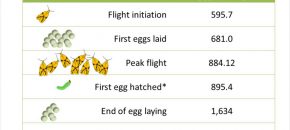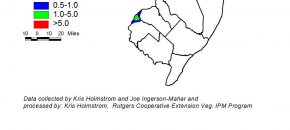Click to View | Download Report 6-20-16 Potato Disease Forecasting Report We will be tracking DSVs for Late blight development and calculating P-days for initiating the first early blight fungicide application. The first late blight fungicide application is recommended once 18 DSVs accumulate from green row. Green row typically occurs around the first week in May […]
Continue reading...Bee Safety Should Come First
There are several actions that growers can implement in their farms to help protect bees against exposure to pesticides. Here I list a few: Use insecticides only when needed. Cranberries growers are very proactive and practice integrated pest management (IPM). Using insecticides only when pest populations exceed an economic threshold will help reduce exposure of […]
Continue reading...Potato | Tomato Disease Forecast 6-17-16
Click to View | Download Report 6-17-16 Potato Disease Forecasting Report We will be tracking DSVs for Late blight development and calculating P-days for initiating the first early blight fungicide application. The first late blight fungicide application is recommended once 18 DSVs accumulate from green row. Green row typically occurs around the first week in May […]
Continue reading...Vegetable Disease Briefs – 6/16/16
There have been no new reports on late light in the region. Late blight (US23) was reported on potato on the Eastern Shore two weeks ago. All tomato and potato growers in the region should scout on a regular basis. Blackleg caused by Dickeya has been reported in potato this past week. Cucurbit downy mildew […]
Continue reading...Cranberry Pests During Bloom, With Attention to Sparganothis fruitworm

Cranberry beds are in bloom. If insects have been effectively managed prior to bloom, we recommend no sprays at this time. A reminder: when bees are present your only choices of insecticides are insect growth regulators (IGRs) such as Intrepid 2F or Bt products such as DiPel. During bloom we recommend monitoring insect populations using […]
Continue reading...Veg IPM Update: Week Ending 6/15/16

Sweet Corn Catches of European corn borer (ECB) have declined through much of the state. Remaining areas of highest activity include parts of Monmouth, Mercer and Salem counties (see ECB map). ECB infestations are now rising in sweet corn plantings, but are well below normal levels. Feeding ranges from single digits to 20% in areas […]
Continue reading...